A child’s rosy cheeks can be a sign of good health, but a bright red rash that suddenly appears on your little one’s cheeks can be a symptom of Fifth disease.
Fifth disease, also known as “slapped cheek rash,” is a viral illness most commonly diagnosed among children ages 5 to 15. It is caused by parvovirus B19, which is spread by coughing and sneezing.
“The rash usually comes in three phases,” says Dr. Lisa Centilli, a family medicine physician at Tidelands Health Family Medicine at The Market Common. “The first phase is a rash on the cheeks, which is sometimes followed several days later by a rash on the trunk of the body. After it clears up, the rash can come back intermittently for several weeks, usually after exposure to heat or sunlight.”
Other symptoms can include a runny nose, low-grade fever, headache, nausea, sore throat or joint pain. The typically mild virus is most commonly spread in late winter, spring or early summer.
Dr. Centilli says healthy patients typically fight off Fifth disease in one to three weeks.
“If a patient is experiencing a low-grade fever or headache, we may recommend taking an over-the counter medication with acetaminophen or ibuprofen. Patients should also get plenty of rest and drink lots of fluids,” she says.
While the bright red rash may prompt parents to keep a child home from school or day care, Dr. Centilli says that’s generally not needed.
“By the time the rash appears, a child is no longer contagious,” she says.
Although more common in children, Dr. Centilli notes the virus is sometimes diagnosed in adults, too. Some adult patients, especially women, experience extended periods of joint pain and swelling, though it typically goes away without long-term problems.
She notes it’s important for pregnant women who believe they may have been infected with Fifth disease or exposed to the virus to contact their OB-GYN or other qualified care provider. In rare instances, the infection can lead to anemia in the baby, which can increase a woman’s risk of miscarriage.
“There is no treatment for the illness among pregnant women, but a physician may require more prenatal visits, bloodwork and ultrasounds to keep a close eye on the unborn baby,” she says.
